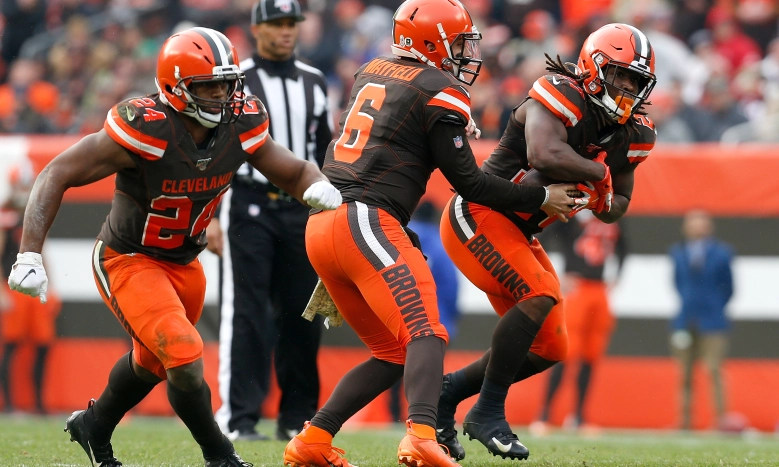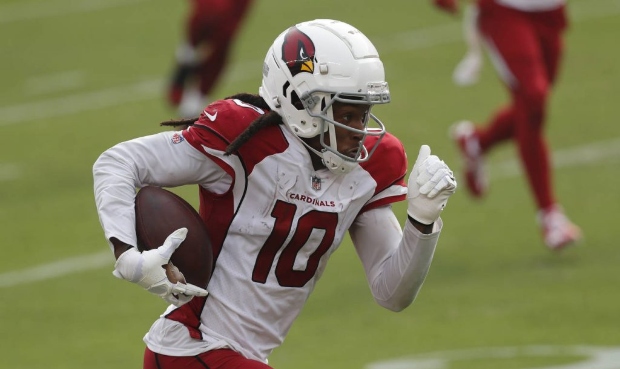If you have any questions about the code here, feel free to reach out to me on Twitter or on Reddit.
If
you prefer to read this in the form of a jupyter notebook, here's a link to that. You can also download the
source there.
Shameless Plug Section
If you like Fantasy Football and have an interest in learning how to code, check out our
Ultimate Guide on Learning Python with Fantasy Football Online Course. Here is a link to purchase for
15% off. The course includes 15 chapters of material, 14 hours of video, hundreds of data sets, lifetime
updates, and a Slack channel invite to join the Fantasy Football with Python community.
Kareem Hunt's Impact on Nick Chubb FF Output
How did Kareem Hunt affect Nick Chubb's output towards the end of the season? Let's use some data visualization
to see how Hunt's arrival in to the offense affected Chubb's output. In future posts leading up to this year's
Fantasy Football drafts, I want to do a further deep-dive in to Chubb's profile. He's in a critical spot in the
draft. According to ADP data, he is likely to go around pick 11 - 17 in most leagues. This spot in next year's
draft is going to be running back dense - filled with the likes of Josh Jacobs, Aaron Jones, Nick Chubb, Mixon,
Henry, and maybe even Fournette. If you land in this spot, making the right decision here is likely going to
make or break your entire season. For that reason, the first string of posts in our Fantasy Football analysis
series is going to focus on this turn in the draft and this group of running backs.
In this post, we are just going to look at one aspect of the Nick Chubb dilemma - Kareem Hunt's impact on his
performance and what that potentially means for 2020. No one denies that Nick Chubb is a beast - and while this
post might seem down on Chubb's profile, I think future posts will show that he still can be a valuable RB2 in
your lineup in 2020.
Let's start off a new jupyter notebook by importing some libraries.
There was hopeful optimism amongst Chubb owner's last season that Hunt's entrance in to the offense would not
affect Chubb's output. The theory was that if Hunt can improve the offense and help move the chains on a few
drives, then that would make up for the reduction in Chubb's FF output due to being in a timeshare. In short,
Chubb's share of the offense would drop, sure, but the offense itself will grow also so those two factors will
offset each other, leaving Chubb's output unaffected. That was hopeful to say the least.
Did the offense ever grow? Did this theory actually come true? We'll find out in this post.
To start, let's make an empty DataFrame and concat together weekly data for
2019 to make one big DataFrame. You can find weekly data underneath the "Data Sets" tab in the navigation bar.
Next, let's find Hunt and Chubb in our df.
Now we're ready to run our data visualizations. We are going to be noting the change in Chubb's usage and
fantasy output before and after Hunt's arrival, and also how the entire offense changed.
Chubb's mean usage, defined as targets + number of carries did drop following Hunt's arrival into the offense.
Let's visualize this data using matplotlib.
We use 10 as the cutoff week because that is the week Hunt came back from suspension. Below is what we get as an
output.
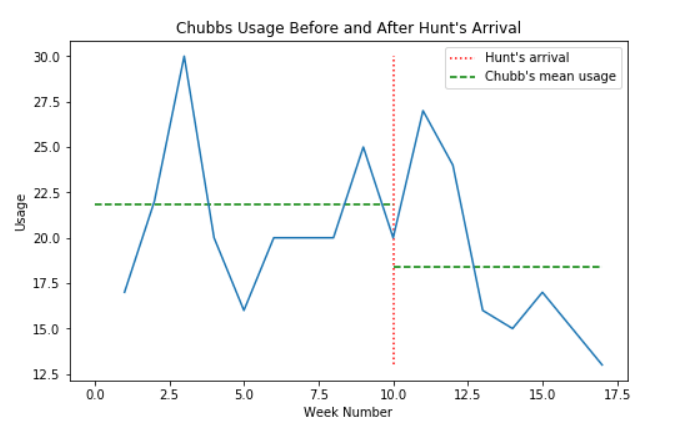
Based off this visualization, things are not looking good for Chubb. Moreover, Chubb's usage stayed high 2 weeks
after Hunt's arrival, but steeply dropped off thereafter. This may have been because it took 2 weeks for Hunt to
"find: his role in the offense. Week 17 was a weird week and will continue to show up as a weird/outlier week in
our visualizations. Starters didn't get benched this week - which was my first thought. The offense just didn't
perform against the Bengals. Baker threw 3 INTs and Chubb and Hunt had a combined number of carries of 16 for 45
yards. Yikes.
Anyway, the green line shows Chubb's mean usage in the offense before and after Hunt's arrival. Usage, again, is
defined as targets + number of carries. As you can see mean usage dropped, and there was a downward trend in
Chubb's involvement of the offense. The red dotted line marks the arrival of Hunt into the offense.
Let's run the same process, but this time for Chubb's Fantasy Football output instead of usage.
Down from 17 points per game to 11. Oof. Let's plot this data.
And our output below.
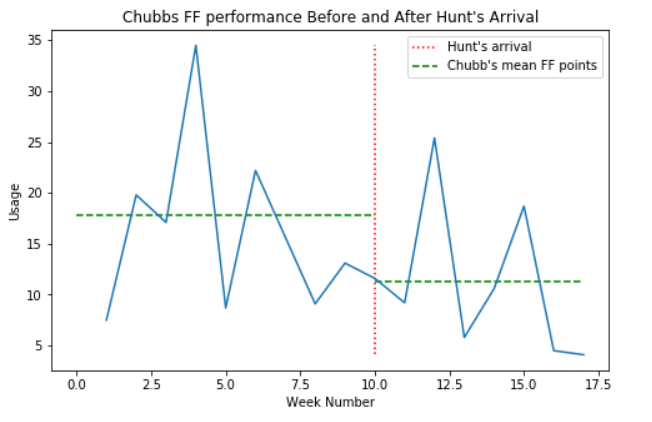
Looking at mean Fantasy Football output tells an even bleaker picture. Chubb's mean FF output dropped from 18 to
11 points per game.
Could all of this have been that the RB offense got worse after Hunt's arrival? In other words, the exact
opposite of what all the hopeful Chubb owners thought last season? As we'll see below, the offense, on average,
stayed the same.
As you can see, the mean output for Cleveland's RB core in terms of FF performance did not increase. Again,
let's plot this data and visualize the results.
And one more time - our output below.
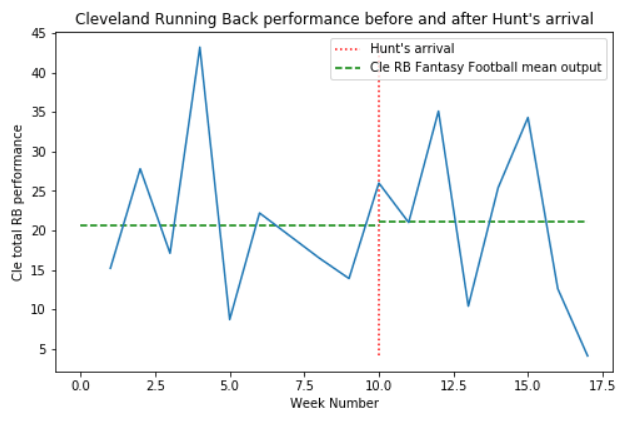
As you can see, the mean output of the offense over the timespan between Hunt being suspended and after his
arrival is more or less the same. We can do some more visualizations here, like plotting the usage of the
offense as a whole. We can also look at Chubb's percentage share of the offense based off these numbers. But
think about it for a minute. If the offense produced the same amount of RB Fantasy Points before and after Hunt,
the offense did not grow. If the offense stayed the same, and Chubb's mean output also decreased, then that
means that Chubb lost a share of the offense. It seems as though the Chubb hopeful's predictions didn't come
true after all - the RB share of the offense did not grow, and as a result, Chubb lost value.
This is probably not a great look looking forward to 2020 for Chubb. Hunt is going to remain a part of the
offense, so it looks like for the time being, this timeshare is going to continue. I don't want to speculate on
it too much as we only saw a glimpse of it during the 2019 season, and Chubb is shaping out to actually be a
fantastic NFL running back. In future posts, we are going to analyze Chubb's profile even further and try to
find some light at the end of the tunnel for taking him in the 2nd round turn.
